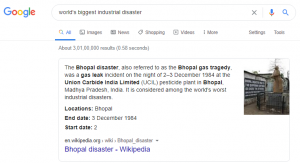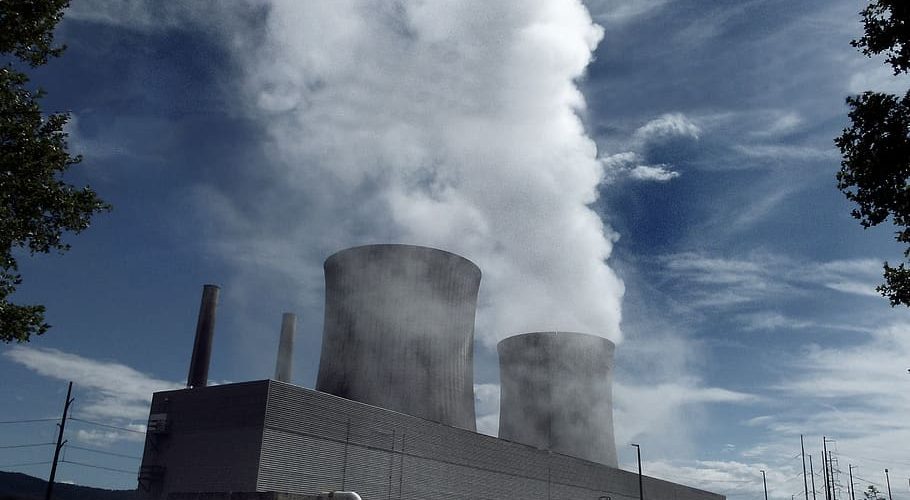Type “world’s biggest industrial disaster” in Google, you will get the following result –


Here are some of the industrial disasters in India (it is only a partial list)
2 December 1984 – a gas leak incident at the Union Carbide India Limited pesticide plant in Bhopal, Madhya Pradesh. The poisonous gas leak immediately killed more than 3,000 people and affected over 500,000.
27 June 2014 – a massive fire broke out following a blast in the underground gas pipeline maintained by the Gas Authority of India Limited at Nagaram, Andhra Pradesh. The fire killed at least 15 people and more than 40 people injured.
6 May 2017 – a chemical leak at a container depot near two schools in Tughlaqabad depot. More than 400 school children were hospitalized after inhaling the poisonous fumes.
9 October 2018 – an explosion in a gas pipeline killed 9 people and injured 14 people injured at the Bhilai Steel Plant of state-owned SAIL.
7 May 2020 – a gas leak from LG Polymer factory in India’s port city Visakhapatnam killed more than 10 people.
Why I am telling all this? People lost their lives, kids were hospitalized, grievous injuries were caused – all this – because a company and its factory were negligent in following safety standards.
It is not just about immediate or visible damage, the slow destruction on the environment and natural resources is immense. If you have ever passed by a factory with a foul smell, even standing for a few minutes is so painful, imagine the plight of people who would be living in the vicinity.
Then there is wastewater which emanates from the factories, if it is not treated properly it gets mixed with the nearby rivers or lakes, which would supply drinking water to the neighborhood.
and who can ignore environmental damages – air & water pollution, deforestation, land degradation, illegal mining, etc?
What is India’s connection with Environmental rules & regulations?
India became a signatory to the Stockholm Declaration on Environment in 1972 and subsequently enacted laws to control water and air pollution. But only after the Bhopal gas tragedy, India woke up and passed legislation for environmental protection in 1986 and put in place a framework for Environment Impact Assessment. In 1994, the government of India established the Environmental Impact Agency (EIA) and made it mandatory to obtain the Environmental Clearance (EC) certificate.
What is Environment Impact Assessment (EIA)?
Environment impact assessment is a process to regulate activities of industrial and infrastructural projects that affect (read pollute, contaminate) our water bodies, air, forests, land.
What is the context?
Any developmental project in India needs to obtain clearance or no objection certificate from various government ministries, state departments, and local municipalities.
One of the clearances which are required is Environmental clearance, to ensure that all the environmental norms are fulfilled. In the case of any violations, the company needs to elaborate on the scale of the problem and on the precautionary measures.
The EIA ensured that all projects require clearances from the environment point of view and only when it is cleared the project could go ahead.
Environment Impact Assessment – Balance between economic development & environment protection
The developmental activity requires land, resources – sometimes at a cost of their destruction – including on the environment.
Many times, this causes friction between advocates of the environment and the industrialists.
The purpose of EIA is to ensure the company, government, and the public find a balance between economic growth and environmental harmony.
2020 Changes and contention
In order to evolve as per the changing times, the government keeps making amendments & provisions to the Environment Impact Assessment (EIA). The recent draft has been proposed by the government –
- Post facto approval – Clearances of projects can be given even if they are started construction or in the running phase without securing environmental clearance. The logic is, the development is necessary for the economy and environmental clearances should not act as an impediment.
Contention: It means that any environmental damage caused by the industry is likely to be ignored by the government and the company may get away by simply paying a fine which might not be anywhere close to the damages caused to the environment.
- Public consultation process – It provides for a reduction of the time period from 30 days to 20 days for the public to submit their responses during a public hearing for any application seeking environmental clearance.
Contention: Such a short time might not be enough for a meaningful and fair public discourse. It’s like the government wants to close things before even the public realizes the consequences.
- Relaxation of monitoring requirements – In earlier notification projects had to submit a compliance report every six months to the government to check whether the projects are adhering to the rules. However, the 2020 draft requires the promoter to submit a report only once every year.
Contention: The 6 months time frame allowed the government to keep a check on the projects and actions can be taken accordingly. The increase in the time frame to one year will allow the business to flout the rules for a longer duration.
- Strategic Projects – The government can categorize a project as strategic and then it gets the power for not letting out any information related to that project out in the public domain.
Contention: If a strategic project violates any environmental norms who is going to report,






Add comment